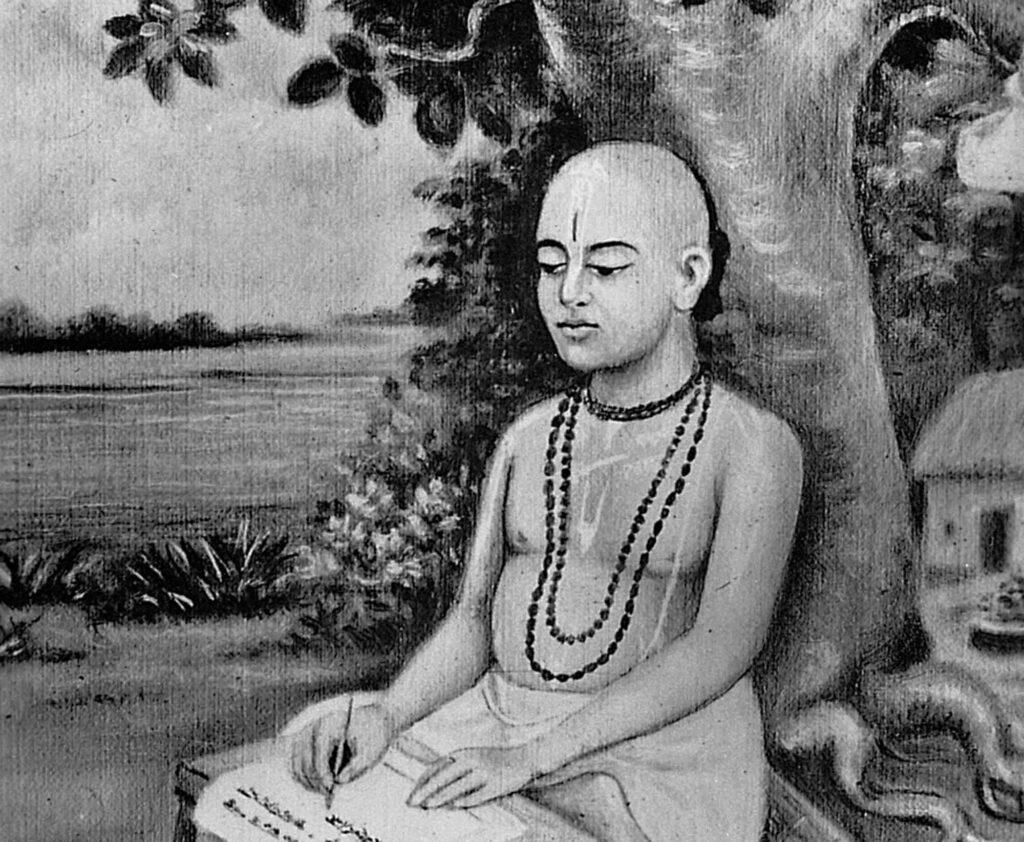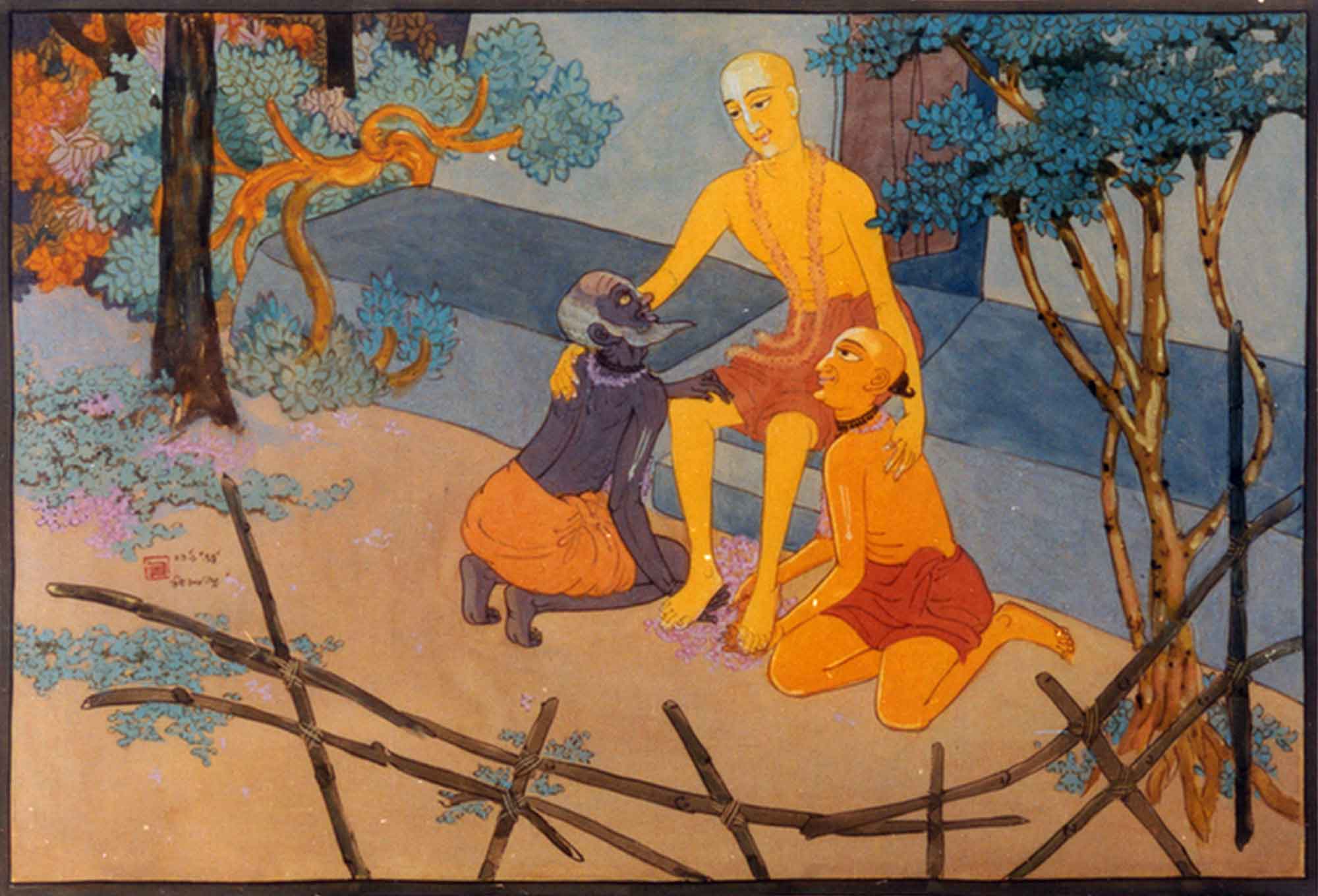Overview
Samālocana – Rasa Śaivalinī Gītā (A Critique of the Book Rasa Śaivalinī Gītā) was first published in Sajjana Toṣaṇī, Vol.10 Issue 6 in 1898. Bhaktivinoda Ṭhākura reviews a book by Pañcānana Gosvāmī Padaratna, and warns how some so-called ‘sādhus’ misuse works such as Ujjvala Nīlamaṇi in order to engage in nefarious activities.
(translated by Swami B.V. Giri)
Rasa Śaivalinī Gītā (‘A River of Rasa’) by Śrī Pañcānana Gosvāmī Padaratna costs 4 ānnas only. This book is complete with 48 pages. The publisher is Hari Dāsa Datta. This book is extremely inaccurate. The ślokas quoted throughout are incomplete and have totally incorrect meanings. At the beginning of this book, Padratna Mahāśaya has written this:
śrī bhāgavata ācārya gosvāmine namaḥ
śrī-gosvāmī sārvabhauma dvija udāsīna
palasanāte vipralaye haiya āsīna
(“Śrī Gosvāmī Sārvabhauma was a brāhmaṇa philosopher. He resided in the brāhmaṇa section of Palsona.”)
bahu dharma śikṣā dena priya bhakta-gaṇe
tan-madhyete śreṣṭha dāsa gopālābhidhāne
(“He taught many types of dharma to the dear devotees. Amongst them, the best was named Dāsa Gopāla.”)
prabhura caraṇa dhari kariya minati
kahe āmi jñāna-hīna narādhama ati
(“Grasping the feel of his master, he said, ‘I am without any knowledge and I am the lowest amongst men.’”)
kṛpā kari kaha prabho upāsya śreṣṭhake
prabhu kaheśuna tāhā kahi ye pratyeke
(“‘Kindly be merciful prabhu, and tell me what is the most worshippable object?’ His master replied, ‘Listen to this and tell this to one and all.”)
eka brahma advitīya sakala saṁsāre
karmera kāraṇe mātta bahu mūrti dhare
(“‘Brahman is one without a second within the entire material world. To perform activities, He appears in many forms.’)
yei yei mūrti cinte sei mūrti sāra
īśvara sakala mūrti janibe nirdhāra
(“‘Whichever form you meditate upon, that form is the best. You should know that ultimately all those forms are Īśvara.’)
bhakti-bhāve ye mūrtira ye kare pūjana
pūjā dravya se īśvare haya samarpaṇa
(“‘Worship that form with bhakti. Offer items of worship to Īśvara.’”)
dāsa kahe śuna prabho kari nivedana
āmi kona devatāra kari upāsana
(“Dāsa said, ‘Please hear my request, prabhu. Which Devatā should I worship?’”)
prabhu kahe śuna kahi śāstrera pramāṇa
raja tama bhaji mare iṣṭha apamāna
(“His master said, ‘Listen, to this śāstrika evidence. One who worships in the modes of passion and ignorance desires death and is disgraceful.’)
rāvaṇa pauṇḍrāka vāṇa āra vṛkāsura
brahmā śiva bhaji tāra śeṣe darpacūra
(“‘Rāvaṇa, Pauṇḍrāka, Vāṇa and Vṛkāsura worshipped Brahmā and Śiva, but were ultimately arrogant.’)
ataeva sattva guṇa karaha cintana
raja tama kari tyāga vedera racana
(“‘Therefore, meditate upon sattva-guṇa, and give up the modes of raja and tama – this is the explained in the Vedas.’)
bhṛgu ādi muni-gaṇa karila nirṇaya
sattva guṇa avalambi viṣṇu suniścaya
(“‘It is the conclusion of Bhṛgu and other sages that one should certainly follow Viṣṇu in sattva-guṇa.’)
ataeva kara sadā kṛṣṇa upāsanā
kṛṣṇa bhinna tri-jagate dayāla dekhi nā
(“‘Thus, always worship Kṛṣṇa, for you will not see anyone else in the three worlds who is as merciful.’)
śrī kṛṣṇa bhajana haya sarva sārāt-sāra
tadapekṣā upāsanā śreṣṭha tvadīyāra
(“‘Bhajana of Śrī Kṛṣṇa is the essence of all things. His is the best kind of worship.’)
tvadīyāra madhye śreṣṭha rādhā ṭhākurāṇī
ataeva rādhā-kṛṣṇa bhaja śreṣṭha jāni
(“‘Along with Him, there is also the most excellent Rādhā Ṭhākurāṇī. Thus, I know that the worship of Rādhā-Kṛṣṇa is the best.’)
dāsa kahe rādhā-kṛṣṇa līlā guṇa-rūpa
varṇana karuṇa āra doṅhāra svarūpa
(“Dāsa said, ‘Kindly describe the nature of the Two, as well as Kṛṣna’s līlā, guṇa and rūpa.’)
prabhu kṛta rādhā-kṛṣṇa rupānuvarṇana
tad anusārete kahe dīna pañcanana
(“His master described Rādhā-Kṛṣṇa’s form etc. The fallen Pañcānana has narrated this accordingly.”)
The village of Palsona written about in this verse is in the district of Burdwan. We do not know of any person there who is Gosvāmī Sārvabhauma, the brāhmaṇa philosopher. The author, Pañcānana, seems to be his disciple. There is nothing wrong with the teachings. The point is that pure Vaiṣṇavas follow the śāstra to engage in activities of pure bhakti, whereas some secret sects only reveal a few explanations of the śāstra so that they can indulge in sense enjoyment and commit many kinds of misconduct. They claim that all these activities are a parama-rahasya (great secret) and express that the pure devotees are just dry vaidhi-bhaktas (devotees attached to śāstrika rules). In fact, many kinds of misconduct have arisen in the name of dharma in the age of Kali. Pure devotees should be especially careful and protect their character – this is our advice. The intention of these secret sects is to create some trouble by using ślokas from Ujjvala-Nīlamaṇi. It is most deplorable to take pleasure in destroying the dharma of innocent women and foolish people.
The book Rasa Śaivalinī Gītā does not reveal any evil philosophy. Some of the songs about vraja-līlā have been composed by Padaratna Mahāśaya, and although the language of the songs is not pure and the metre is not melodious, they may contain some selfless bhajana. But we are very disturbed to see the previous books of Padaratna Mahāśaya. Our fear is that there may be something else to cover over and hide with a sheet!
However, we simply want to state that the meaning of Śrī Ujjvala-Nīlamaṇi is most confidential. The līlā of Śrī Kṛṣṇa is completely aprākṛta (transcendental to all things material). Although it enters the mundane world, there is no trace of mundanity about it. The extremely pure rasa-līlā has descended to the material world along with Vraja from Goloka by the great potency of Śrī Kṛṣṇa for the auspiciousness of the jīvas. The union between male and female with this material human body is most disgusting. The jīva’s attainment of the form of a gopī in a spiritual body, and the achievement of Kṛṣṇa’s association is beyond the twenty-four material elements. Even if there is any male distinction within the secret sects, in their spiritual body, everyone is female. The physical external bodies of men and women will always be different. Let there be separate places for women to do bhajana, and separate places for men to do bhajana. Why don’t they come together? Because for those persons who wish to enter rasa-tattva, the virasa (repugnant material rasa) between mundane men and women will gradually arise again. Then one will misinterpret the śāstra in an attempt to save one’s character, and in doing so, offences against advanced sādhus will take place. In this way, many of the secret ‘rasikas’ fall down and become despised by the world as ordinary lustful men and women. If you wish to engage in kṛṣṇa-bhajana, you must become a sādhu. Women should not associate with men, and men should not associate with women. As we remove material thoughts and our mundane nature diminishes, our spiritual nature gradually advances, and we will achieve a birth as a gopī. If you do not become a gopī, you cannot engage in kṛṣṇa-bhajana.













